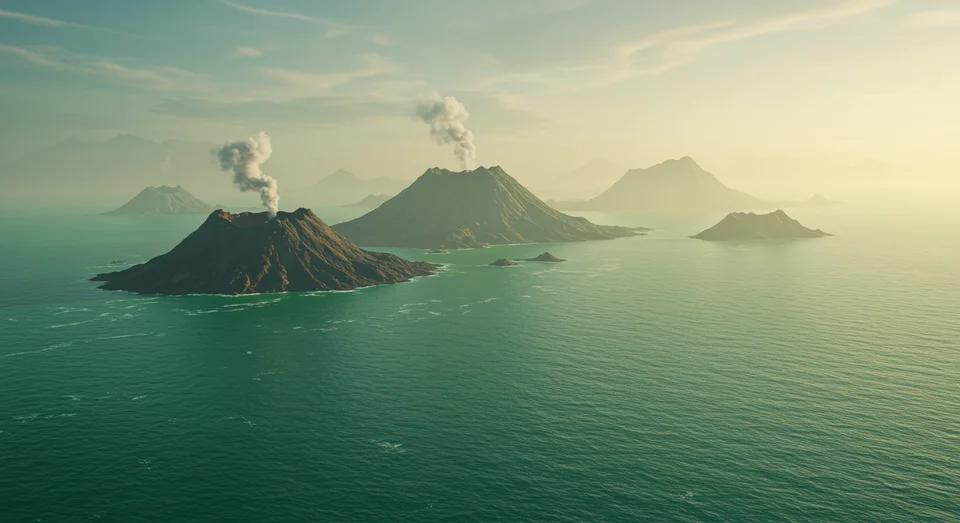Japanese Researchers Reveal Earths Ancient Oceans Were Once Vibrant Green, Offering Clues to Alien Life
164 views
Earth’s oceans, shimmering in their iconic blue today, may have once been a vibrant green, painting a vastly different portrait of our planet’s ancient past. According to a groundbreaking study by Japanese researchers published in Nature, the color shift was likely driven by a confluence of chemical transformations and the dawn of photosynthetic life during the Archaean eon, a period spanning from 3.8 to 1.8 billion years ago. This discovery not only reimagines Earth’s primordial seascape but also offers tantalizing clues for identifying life on distant worlds.

A Green Past: The Chemistry and Biology Behind Ancient Oceans
Long before Earth’s skies turned blue and its oceans reflected their azure hue, the planet was a far less hospitable place. During the Archaean eon, the atmosphere and oceans were devoid of oxygen, a stark contrast to the oxygen-rich world we inhabit today. Early life forms, primarily photosynthetic microorganisms, thrived in this anaerobic environment, relying on processes that did not yet involve oxygen. These humble organisms would ultimately set the stage for one of Earth’s most transformative events: the Great Oxidation Event, when oxygen began to accumulate in the atmosphere approximately 2.4 billion years ago.
The study reveals that the green tint of ancient oceans likely arose from high concentrations of dissolved iron in seawater. Iron, abundant in Earth’s early oceans due to volcanic activity and the lack of oxygen to precipitate it out, interacted with pigments in primitive photosynthetic organisms, such as phycoerythrobilin (PEB). This pigment, still found in modern cyanobacteria, absorbs light in ways that could have given the water a greenish hue. Computer simulations and observations of volcanic islands, where green-tinged waters are occasionally seen today, lend credence to this theory.
The implications extend beyond Earth’s history. The researchers propose that pale-green oceans observed on exoplanets might serve as a visual marker for early photosynthetic life. Such a discovery could revolutionize the search for extraterrestrial life, offering a new lens through which scientists might interpret planetary data collected by telescopes.
The Ever-Changing Palette of Earth's Oceans
The idea of green oceans may seem alien to us now, but Earth’s waters have never been static in their appearance. Geological timescales reveal a dynamic interplay between chemistry, biology, and environmental conditions, each leaving its mark on the oceans’ color. The transition from green to blue, for instance, was not instantaneous. As photosynthetic organisms began producing oxygen, iron in the oceans oxidized and precipitated out as rust, a process that ultimately cleared the water of its greenish tint. The result was the cerulean expanse we recognize today.
But the story doesn’t end there. The researchers suggest that Earth’s oceans could undergo further chromatic shifts in the distant future. Factors such as volcanic eruptions, shifts in water chemistry, or even the aging of the sun could alter the oceans’ hues once more. Depending on the dominant elements and organisms in the water, the seas might one day appear purple, red, or take on entirely unexpected shades. This fluidity underscores the interconnectedness of life and environment, where even the color of the oceans serves as a testament to the forces shaping our planet.
Lessons for the Search Beyond Earth
While the study offers a vivid reimagining of Earth’s past, its broader implications may lie in the search for life beyond our solar system. The notion that pale-green oceans could signify early photosynthetic life provides a new framework for astrobiology. Planets with such features might be prioritized for further observation, as they could represent worlds in a similar stage of evolution to Earth’s Archaean eon.
However, interpreting these signals will require caution. The color of a planet’s oceans—or its atmosphere—can be influenced by a multitude of factors, not all of which point to life. Methane, sulfur compounds, and other non-biological processes can also create striking visual effects when viewed from space. Even so, the possibility that Earth’s ancient oceans hold the key to identifying life elsewhere is an exciting prospect, one that blurs the line between planetary science and evolutionary biology.
A Reflection on Earth's Dynamic Nature
The study serves as a poignant reminder of Earth’s ever-changing nature. The oceans we take for granted today are but a fleeting moment in the planet’s 4.5-billion-year history, their color a reflection of the life and chemistry that define them at any given time. From the green waters of the Archaean eon to the blue expanses of the present, Earth’s seas are a testament to the planet’s ability to adapt and evolve.
As we look to the stars, searching for signs of life on distant worlds, we might also find ourselves looking back—back to a time when Earth’s oceans glowed green, signaling the dawn of life as we know it. In doing so, we gain not only a deeper understanding of our own planet but also a sense of connection to the broader cosmos, where the colors of distant seas may one day tell stories of life’s beginnings.
